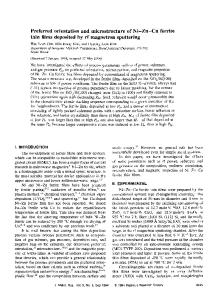HfO 2 -based Thin Films Deposited by RF Magnetron Sputtering
- PDF / 244,828 Bytes
- 6 Pages / 595 x 842 pts (A4) Page_size
- 86 Downloads / 404 Views
1160-H05-08
HfO2-based thin films deposited by RF magnetron sputtering L.Khomenkova1, C. Dufour1, P.-E. Coulon2, C. Bonafos2, F.Gourbilleau1 1 CIMAP, UMR CNRS 6252, ENSICAEN, 6 Bd Mal Juin, 14050 Caen Cedex 04, France 2 CEMES/CNRS, 29 rue J. Marvig, 31055 Toulouse Cedex 04, France ABSTRACT HfO2-based layers prepared by RF magnetron sputtering were studied by X-ray diffraction, infrared absorption spectroscopy and transmission electron microscopy techniques. Since the stability of amorphous structure of HfO2-based layers is interesting from microelectronic application point of view, the effect of the deposition parameters and post-deposition annealing treatment on the properties of the layers was investigated. The amorphous-crystalline transformation of pure HfO2 layers is observed to be stimulated by annealing treatment at 800 °C. It was found that the incorporation of silicon in HfO2 matrix allows to prevent crystallization of the layers and to shift the crystallization temperature to values up to 900 °C. INTRODUCTION Transition-metal-oxides have numerous applications in optics, chemistry, bio- and microelectronics. The latter domain has to face the continuing scaling down of CMOS devices linked with an increase of their number on industrial chips. Unfortunately, SiO2 and related oxynitrides met their fundamental limits as conventional gate dielectrics. Therefore, high-k gate dielectrics were investigated as alternative gate dielectrics. One of the promising materials is hafnium oxide [1,2]. It offers a high thermal stability, a wide band gap and a high permittivity which is the most important point required to circumvent the problem of high leakage current. However, in a thin film approach, the structure and the properties of HfO2 layers strongly depend on the deposition conditions and the post annealing treatment. Various deposition techniques such as ALD [3-5], PVD [6], CVD [7] have been used for the fabrication of HfO2 films, though RF magnetron sputtering is not commonly addressed. Up to now the deposition of HfO2 layers has been performed by reactive sputtering of a pure metal Hf cathode in Ar+O2 gas mixture [8]. Only in a few cases, a pure HfO2 target was used for films fabrication [9,10]. A serious problem for the application of HfO2 films is its low crystallization temperature (much less than 500 °C) since, in the crystalline phase, the grain boundaries act as diffusion paths for oxygen or dopants into the dielectric gate. Thus, a lot of efforts were devoted to improve thermal stability of the amorphous structure. It was shown that nitrogen incorporation into the oxide matrix during deposition or post-deposition processes leads to the formation of HfON [8] and shifts the crystallization temperature up to 1000 °C [11]. It was also observed that amorphous HfSiON layers are stable after such annealing treatment, while the HfSiO ones are crystallised. In the two last cases the layers were grown by reactive sputtering of HfSi target in Ar+O2 and/or Ar+N gas mixture [11]. In the present study, the properties of
Data Loading...










